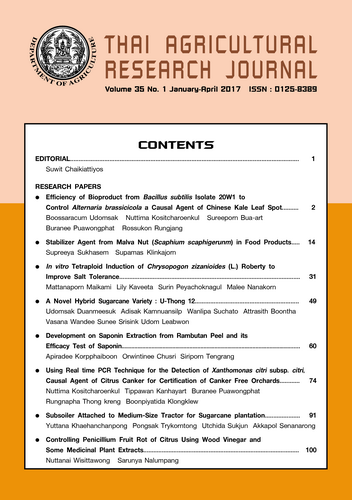In vitro Tetraploid Induction of Chrysopogon zizanioides (L.) Roberty to Improve Salt Tolerance
DOI:
https://doi.org/10.14456/thaidoa-agres.2017.20Keywords:
Vetiver grass, tetraploid, colchicine, salt toleranceAbstract
Vetiver grass is being used worldwide for soil and water conservation, however, there are no report of recommended salt tolerant germplasms in Thailand. Polyploid induction by colchicine treatment is an efficient technique used to improve abiotic tolerance of many plant species. Therefore, tetraploid of vetiver was induced via in vitro shoots according to a factorial in completely randomized design with two factors (four colchicine concentrations; 0, 0.1, 0.2 and 0.3% and four treatment durations; 12,24, 36 and 48 h) and the DNA content was verified by flow cytometry. It was foundthat the highest tetraploid induction efficiency was 22.22% at the treatment of 0.3%colchicine for 12 h, providing 93.8% survival rate. Total of 53 tetraploid out of 607survived shoots were further studied for stomatal characteristics and determined for their salt tolerance. The significant difference of guard cell length between tetraploid and diploid indicated that it can be used as a primary criterion for screening tetraploid vetiver from a large population of colchicine-treated shoots. Salt tolerance examined in vitro at 0, 1.75, 2.00, 2.25 and 2.50% NaCl (w/v) revealed that survival rate of most
tetraploid accessions was higher than that of the original diploid. To confirm their salt tolerance, four highest salt tolerant tetraploid accessions and the original diploid were transplanted to a natural saline area in Dan Khun Thod District, Nakhon Ratchasima Province for 12 months. The survival rate of selected tetraploid accessions was higher than that of the original diploid and two selected accessions were able to survive throughout the experimental period. This result confirmed that tetraploid induction by colchicine treatment was successfully enhance salt tolerance of vetiver grass.
Downloads
Published
2017-01-24
How to Cite
Maikami, M., Kaveeta, L., Peyachoknagul, S., & Nanakorn, M. (2017). In vitro Tetraploid Induction of Chrysopogon zizanioides (L.) Roberty to Improve Salt Tolerance. Thai Agricultural Research Journal, 35(1), 31–48. https://doi.org/10.14456/thaidoa-agres.2017.20
Issue
Section
Technical or research paper
License
Copyright (c) 2017 วารสารวิชาการเกษตร (Thai Agricultural Research Journal)

This work is licensed under a Creative Commons Attribution-NonCommercial-NoDerivatives 4.0 International License.
Thai Agricultural Research Journal



